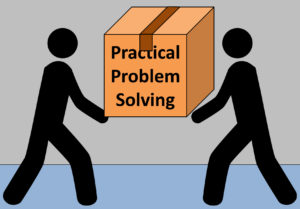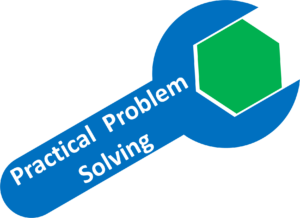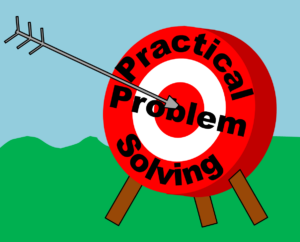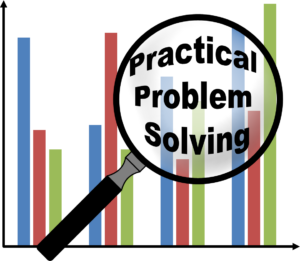 This post of my series on Practical Problem Solving (PPS) looks at what to do after you have done the “Do” part of PDCA. Yes, that’s right, after implementing the solutions you are not done yet. You need to monitor the outcome to see whether it has actually achieved the target you set much earlier. Here, the next steps can go into two directions. This would be the “Check” of PDCA. If you have not yet achieved the target… well… then you are not yet done and need to keep on working on the problem. If you have achieved the target, congratulations! Now share the wisdom with others. This is the “Act” of PDCA. Let me explain in more detail.
This post of my series on Practical Problem Solving (PPS) looks at what to do after you have done the “Do” part of PDCA. Yes, that’s right, after implementing the solutions you are not done yet. You need to monitor the outcome to see whether it has actually achieved the target you set much earlier. Here, the next steps can go into two directions. This would be the “Check” of PDCA. If you have not yet achieved the target… well… then you are not yet done and need to keep on working on the problem. If you have achieved the target, congratulations! Now share the wisdom with others. This is the “Act” of PDCA. Let me explain in more detail.
PDCA
Toyota Practical Problem Solving (PPS)—Countermeasures and Implement
 In this post of my series on the Toyota Practical Problem Solving (PPS), we finally get to the part many were excitedly waiting for—the development of countermeasures and their implementation. Some people like this part of actually doing the improvement (and hence finally the “Do” part of PDCA) so much that they skip the “Plan” part almost entirely. Don’t do that! Properly prepare and analyze before implementing a countermeasure. Without the plan, the countermeasure may be flawed.
In this post of my series on the Toyota Practical Problem Solving (PPS), we finally get to the part many were excitedly waiting for—the development of countermeasures and their implementation. Some people like this part of actually doing the improvement (and hence finally the “Do” part of PDCA) so much that they skip the “Plan” part almost entirely. Don’t do that! Properly prepare and analyze before implementing a countermeasure. Without the plan, the countermeasure may be flawed.
Toyota Practical Problem Solving (PPS)—Targets and Root Causes
 In the previous posts on this series of the Toyota Practical Problem Solving (PPS) I went into detail on how to understand the problem by clarifying the problem and breaking it down to get the prioritized problem. In this post I will look at target setting and root-cause analysis. Setting the target and doing the root-cause analysis is still the “Plan” part of PDCA. Only in my next post with the development of countermeasures do we get to the next step of “Do.”
In the previous posts on this series of the Toyota Practical Problem Solving (PPS) I went into detail on how to understand the problem by clarifying the problem and breaking it down to get the prioritized problem. In this post I will look at target setting and root-cause analysis. Setting the target and doing the root-cause analysis is still the “Plan” part of PDCA. Only in my next post with the development of countermeasures do we get to the next step of “Do.”
Toyota Practical Problem Solving (PPS)—Clarify
 In my last post I introduced the Toyota Practical Problem Solving approach (PPS) and gave an overview how it is rooted in PDCA and often used in the form of an A3. Now let’s dig deeper and go into the details of the individual steps. The first is to clarify the problem. The second is to break down and stratify the problem—to try to understand the problem better by looking at it from different angles, preferably using data. In my next post I will talk about target setting.
In my last post I introduced the Toyota Practical Problem Solving approach (PPS) and gave an overview how it is rooted in PDCA and often used in the form of an A3. Now let’s dig deeper and go into the details of the individual steps. The first is to clarify the problem. The second is to break down and stratify the problem—to try to understand the problem better by looking at it from different angles, preferably using data. In my next post I will talk about target setting.
Standards Part 7: How to Write a Work Standard
 In my last post I talked about the different steps on how to do standard work. In this post I will go into more detail on how to write the actual work standard that is put up at the workplace. This will include quite a few examples in different styles, before I will go into a bit more detail for one example in my next post.
In my last post I talked about the different steps on how to do standard work. In this post I will go into more detail on how to write the actual work standard that is put up at the workplace. This will include quite a few examples in different styles, before I will go into a bit more detail for one example in my next post.
Standards Part 3: How to Write a Standard
 Standards are the result of problem solving. In this article I will talk more about how to write a standard, but this is the outcome or the last steps of the problem-solving process. From this post onward I will look more at work standards, although the following is applicable to a lesser extent to part standards. Again, a standard is not something done on its own, but is part of a problem-solving process.
Standards are the result of problem solving. In this article I will talk more about how to write a standard, but this is the outcome or the last steps of the problem-solving process. From this post onward I will look more at work standards, although the following is applicable to a lesser extent to part standards. Again, a standard is not something done on its own, but is part of a problem-solving process.
Hoshin Kanri and the Kanri Noryoku Program: Rejuvenating Toyota
Hoshin Kanri – Part 4: The X-Matrix?

When googling Hoshin Kanri, you will sooner or later come across an X-Matrix. It is a visually very impressive tool, but I am in serious doubt about its usefulness. It focuses on the creation of the Hoshin items, but to me this approach is overkill, and – even worse – may distract the user from actually following the PDCA, especially the Check and Act parts. While the article is highly critical, I hope reading it and understanding the shortcomings help you better understand how Toyota thinks.

